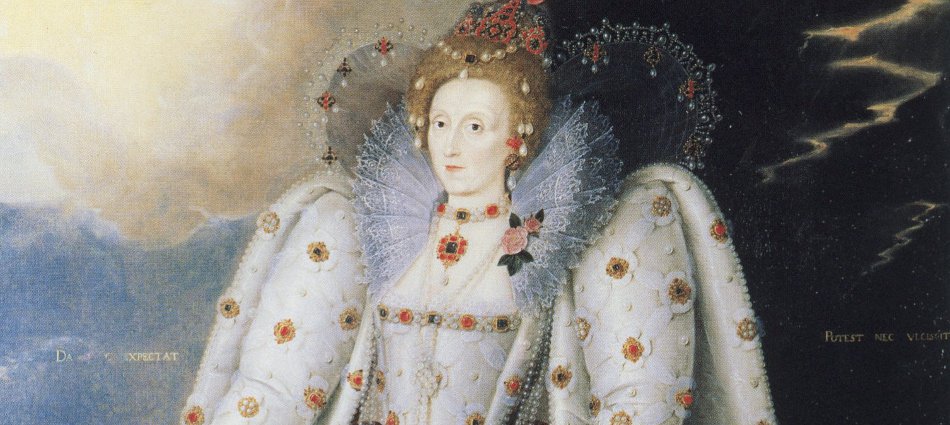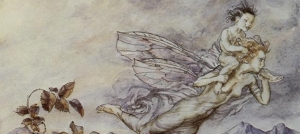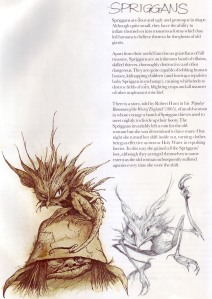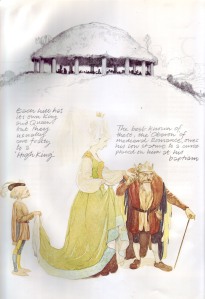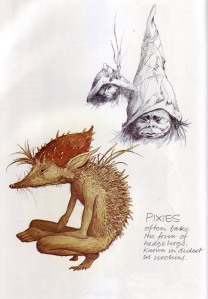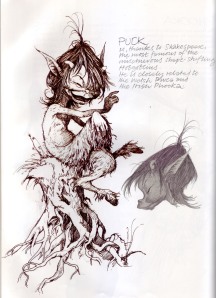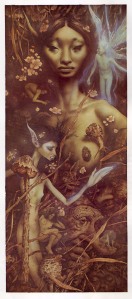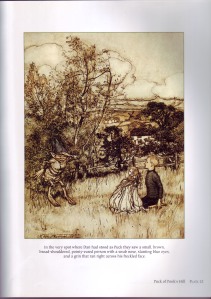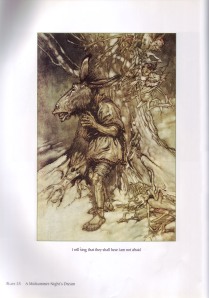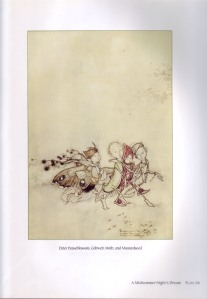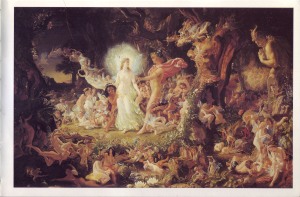Welcome to the online casebook (the caseblog, as it were) for Carnegie Mellon University’s 2010 production of A Midsummer Night’s Dream. Check the sidebar to your right for recent posts and an index of all posts, and please come back often — we’re always adding more information!
Latest
Feedback from Somerset High School
On Friday, Dec. 3, CMU did a special performance of Midsummer for high schools from the Pittsburgh and western PA area. Some students came from as far away as Somerset County. For many of these Somerset students, it was their first chance to see live theatre. Later in the month, we received some great letters from the students. Here are a few of their comments.
Dear Cast,
I have never been at such a loss for words. A Midsummer Night’s Dream, what an epic production. All of you have stunned me into oblivion. Hello, my name is Emily [H]. I am a senior at Somerset High School. I was fortunate enough to see your production and I am so thrilled that I did. This whole cast was so professional and this really stunned me. I was expecting this show to be well done, but not THIS well done.
As a senior in high school, I am now applying to colleges. I am hoping to major in musical theater and I am now considering Carnegie Mellon because of how professional this production was.
After the production, myself, my drama teacher, and a few peers stayed in the lobby and we spoke with the actors and actresses. The student who played Hippolyta was kind enough to give me pointers on my college auditions. She said I needed to show them a spark, the spark that says, “I want her.” I could tell that each individual on the stage, from Puck to the ensemble, had that spark that I needed.
I admire all of you and I hope to make it in the industry as far as I know all of you will. Good luck in all that you do. I know that I will be seeing many of your faces either on television or playbills. Thank you for having such a great production.
-Emily H.
Dear Cast,
You have no idea how many lives you have touched. Most people never get the gift of Shakespeare, but because of your cast you made a whole auditorium fall back in love. My name is Haven and I am a senior at Somerset Area High School. CMU gave us free tickets and an amazing experience. THANK YOU! I am a part of the Shakespeare class and we got to choose a character and I was Portia from Merchant of Venice. We also had a Puck. When the final speech was delivered in the moon I think my world turned upside down.
It was really creative how Puck used transportation devices. It was really funny and made all of us keep wondering what he was going to use next.
I think what made the play is the whole cast. There was never a dull moment because I think that everyone had the mentality that there were no small parts.
Dear Cast of Midsummer Night’s Dream,
I can’t even BEGIN to describe how out-of-this-world AWESOME your production was. Every single actor went above and beyond with their parts, and everyone was hysterically funny. I loved every scene, every actor, every LINE. The lighting and the set were incredible, and the costumes were gorgeous. Puck, You made my life! You were SO funny, and I thoroughly enjoyed all your epic modes of transportation. You rocked the segway, my friend.
All of my friends are still talking about how awesome the play is, and we wish we could come back and see you all again.
Keep being epic!
Love,
Anna B.
Dear Cast,
You’re great. I attended your performance of Shakespeare’s A Midsummer Night’s Dream on Friday, December 34d. By the way, my name is Rori [M.], a senior at Somerset Area School District.
Your show was stellar, hilarious, and breathtaking. I’ll admit that I have only briefly studied this play, and the way that you delivered it made it easy to understand, yet true to the Shakespearean taste.
If I were to choose a favorite performer, it would have to be Ben Ferguson as Puck. Although overall as an ensemble you all did a superb job.
I’d go into a more detailed review, but I’ll leave you with this. Keep doing what you’re doing. You’re great at what you do.
Dear the Cast of Midsummer nights dream,
I’d have to say I thought the play was fabuluous [sic]. I don’t think I could’ve done the same outstanding job. It was quite different and funny.
My favorite characters were Puck because of all the rideable things he kept bringing out, Oberon he was so cunning it just made it so excellent, Titania she is so beautiful and at times quite funny. Also all the fairys [sic] that were copying the humans made it humorous.
My favorite scenes was [sic] when Puck was teasing Demetrius and Lysander.
From seeing West Side Story and Midsummer’s night dream, yours was the best out of the two. I could watch you guys over and over again.
Great show and best of luck to you all in the next.
Sincerely,
Kristy U.
Dear Cast,
Your proformance [sic] of A Midsummers Night’s Dream was amazing. I stayed on the edge of my seat the whole time. The way the fairies always stayed in a constant fluid motion without taking the main characters focus away took talent and practice. Bottom or Tim Harrington acting was great. Always staying in character while being funny and not going overboard and taking away from the story. Helena and Hermia both played their parts perfectly reacting exactly how a girl would and keeping character through all the funny parts. The tech and stage crew did an awesome job on setting the stage and creating al the effects needed to make the show fantastic! Great job everyone.
Sincerely,
Cody
Dear Cast of A Midsummer Night’s Dream,
My name is Brandy [H.], I am a student from Somerset Area High School. I attended your performance on December 3rd. It was by far the best performance of Shakespeare I have ever seen, hands down.
Shakespeare is hard to understand unless it is done well. You guys rocked it! I loved the modern spin that was put into it. And not to mention every actor and actress played there [sic] part perfectly! I must say the set was amazing; plus all of the lights and special effects really set the mood.
All of you had me sitting on the edge of my seat laughing like crazy. When the performance was over I wanted to watch it again, it was outstanding. Bravo everyone!
Sincerely,
Brandy H.
Dear Cast of A Midsummer Night’s Dream,
My name is Payal [P.] and I am writing from Somerset Area High School. I am a senior and fortunately for us our school allows us to go see productions like yours and ocassionally [sic] groups come to perform at our school as well. Out of all the Shakespeare plays that I have seen, this is definately [sic] my favorite. The play was not only humorous but also very easy to follow.
Some of my favorite things about your production would include how the fairies mocked/imitated the main characters when they spoke and all the small details with the lighting and sound when ever Puck cast a spell. I also liked the Idea of the pool of water in the woods. I did not realize it was there until Helena fell into it.
Thank you for working so hard to provide us with the pleasure of getting to watch your recreation of Shakespeare’s A Midsummer Night’s Dream. I would definately [sic] like to watch another play at Carnegie Mellon, and I hope all of you are successful with your next shows.
Sincerely,
Payal P.
Dear Cast,
My name is Bethany [S.] and I attended your performance of Shakespeare’s A Midsummer Night’s Dream. I am writing to tell you how much I enjoyed your performance. Wonderful, spectacular, magical, exciting, all are words that describe your performance of this play. Personally I am usually lost when it comes to Shakespeare, but seeing your performance I was able to follow and understand it thoroughly. I was in absolute awe and fascination as I watched the play. To just sit and think about all the work you all put into it, just to make it possible is incredible! The Shakespeare language is not an easy skill to master either, however all of you were fluent and amazing with your lines. I know I wouldn’t have been able to do that without getting tongue tied. The sets, and costumes, and props were all very creative. I loved the modern costumes. the Lovers wore.
I thank you for your performance of this play as it was mesmerizing, and magical. You all did such an amazing job in your performances as well. I think all of you are amazing actors and I hope that you continue on performing as incredible as you did.
Sincerely,
Bethany S.
Dear Cast,
I thought your play was absolutely amazing! The whole time I was just staring at the stage and couldn’t look away. I loved how you integrated jokes and modern things into it. The settings were just awesome, and I love how the moon changed with the mood of the scene. The lifts were also such a great part of the show.
Which brings me to my favorite character, Puck. I thought you were just awesome – too great to put into words. The way you talked and the motions you went through were so believable. Also, I loved all the different modes of transportation you used. I also can’t go without mentioning the rest of the fairies as well: The way you all moved looked like you would jump up and fly at any minute. I loved all the stances you took, and how you were never just standing there. No matter what the scene, the faeries added to the movement, and acted like scenery themselves.
When Demetrius and Lysander were fighting for Helena, I laughed so hard. When you called Hermia “dwarfish” and high-fived, it was great. All four of you were so amazing together I loved that while Helena talked, the two guys were all “♥ I love you” and when Hermia did, they backed off like “…ugh…”
The construction men were all fantastic. Bottom was just hilarious! I loved when you performed Pyramus & Thisbe. We were laughing like crazy. There were so many great moments (like the wall scene!! haha) I don’t even know what else to say. It was just golden. And “snug” was just so timid and adorable 🙂
Oberon looked so great for his part, and he just looked perfect for who he was playing. Titania was great as well. I loved how there was like two sides of fairies – the Oberon side and the Titania side. Oberon had such great chemistry with Puck.
If there’s anyone I forgot to mention, I’m sorry! But everyone was just too amazing for words. From costumes to acting, everyone was just mind-blowing.
Thanks to all the students who came to see the show! We loved having you there.
“Midsummer” reviewed by Pittsburgh City Paper
http://www.pittsburghcitypaper.ws/gyrobase/Content?oid=oid%3A88377
A Midsummer Night’s Dream
A master of language and dialect, director Don Wadsworth is here burdened with lumps of gimmicks and special effects that never manage to cohere into a solid piece of entertainment. And though trimmed to just under two hours, this brief but tedious Midsummer is still too long to run without an intermission.
Many of the separate parts do very well, especially the polished choreography of the characters, by turns graceful and comedic or both (thank you, Wadsworth and movement coach Catherine Moore). Milim Sung’s lighting and media design, assisted by Erik R. Lawson’s sound, do engender a sense of magic in the theater.
In the large, uneven student cast, the four young lovers shine, particularly Mimi Gianopulous as the spurned Hermia castigating erstwhile friend Helena (Sara Trapnell, deftly turning from spaniel-like to suspicious) for her height. Ryan Melia keeps his charm as Lysander changes his affections, and Corey Scott handsomely transforms from villain to hero.
Alas, once the lovers are reconciled, the Dream stalls and sputters into a Six Stooges skit.
Anne Mundell’s scene design is lovely but misses being glorious. With the exception of a perfectly cut gown for Titania (a purr-fectly beautiful Gabrielle McClinton), costume designer Steve Buechler is not at all kind to the ladies, inflicting upon them painful-looking heels and hideously unbecoming outfits. The fairies look striking, and move like a dream, but present a mixed bag in delivering lines. The perky Ben Ferguson, as Puck, was undercut by a cumbersome running gag of anachronistic transport devices.
I laughed, but not enough. In many years of theater-going I have survived countless Midsummers, some of which are still memorable dreams. This is far from the worst, but not close to the best.
A Midsummer Night’s Dream continues through Dec. 4. Philip Chosky Theater, Carnegie Mellon University, Oakland. 412-268-2407 or www.cmu.edu/cfa/drama/
Midsummer reviewed on WRCT
Original text can be found here!
Theatre review: “A Midsummer Night’s Dream” at CMU to air Sunday 28th November ,2010
Less than a year after Public Theater gave us a colorful, lively version of Shakespeare’s A Midsummer Night’s Dream, CMU’s Drama School give us one even more colorful and lively. As directed by Don Wadsworth, delightful, charming performances come enhanced by fully consistent style with a true sense of ensemble. The words and their essential meanings become constantly clear and, at the same time, the players in comic roles move with panache and personality, well-coached by Catherine Moore. The whole conception has a great sense of fun in a remarkably fresh way, Moreover, Wadsworth doesn’t fool around much with the original concept, taking it out to some new, shaky limb, even though the “real” characters are played in contemporary clothes
Advance publicity says that Wadsworth made cuts and changes. The most noticeable sense of that comes from the fact that the production runs intermissionless in under two hours. Even so, the story and its three-branched developments appear to remain essentially intact. I noticed only one major transposition of the text. It was at the end of the play and in the service of Wadsworth’s intention to emphasize the idea of a dream, in this case making it all seem as if it is Bottom’s dream. Hence Bottom’s bottom is visible on stage throughout all the action, mostly body-doubled. To close the play, no longer recumbent, he says things which, originally, are in a much earlier scene. No great harm there. As for the rest of the concept, it seems immaterial rather than obvious.
Wadsworth and his student cast make the most and best of the two deliberately humorous elements in the play. One is Shakespeare’s wonderful dig at eternally inept theatre folk with Bottom and his buddies and their goofy attempts to put on a show. Wadsworth’s inventions and the cast’s playing do the whole thing hilariously right. The other element concerns the mis-matched lovers losing their way and their reason in the forest. The four students play all of this superbly, full of youthful excess, finding the potential of how the characters behave and speak. Moreover, the playing of straight roles has equal polish and sincerity. You couldn’t ask for better performances, even from professionals.
The third element has always seemed the most problematical, the root of a major plot development. Oberon’s minor dispute with Titania prompts him to have Puck enchant the lovers, which, going awry, creates much merriment. There’s also Titania’s falling in love with an ass, Bottom, a kind of flat-out joke with elemental potential. In other productions I’ve never seen anything done with Oberon, Titania and Puck to make them really interesting. They usually look colorful enough but come across as if they leapt out of a rather standard ballet. In this case Wadsworth and Moore have filled the stage with supple bodies in swirling, gymnastic evocations of ethereal creatures, many of whom come cleverly costumed to look like extensions of the forest and the trees. All of them, including Oberon, Titania and Puck, move adeptly in an intricate, imaginative set. But nothing makes those characters really special. Not an easy assignment for students. For anyone.
Incidentally, advance publicity says that this production has original music by Eric Lawson, a CMU Drama School MFA candidate. The otherwise superbly annotated program book says nothing about that.
Surely, though it be not summer, this entertainment brightens the hours.
The Pittsburgh Post Gazette reviews Midsummer
Original article can be found here.

“A Midsummer Night’s Dream” conjures Shakespeare at his most whimsical and mischievous; you can easily imagine the Bard having an LOL moment as he put quill to parchment and transformed a pompous would-be actor into an ass.
The Carnegie Mellon production directed by Don Wadsworth and performed by a merry band of grad students works hard for the comedy and mines a lot of laughs for their trouble. They bring a modern attitude to the court of Theseus, Duke of Athens, in particular the young lovers who could have marched right out of “Gossip Girl” if not for the 16th-century language. They punctuate conversation with cruelty and kisses and giggles and shrieks as befits lovestruck teenagers.
The dreamscape that these foolish mortals stumble into and that serves as habitat for forest fairies, from the royal Oberon and Titania to servants with names like Mustard Seed and Cobweb, has been rendered with simple beauty by designer Anne Mundell.
There are no sharp angles here. A huge full moon with shine that fades and brightens stands guard behind an elliptical platform with a pool at the center. Feathers flutter about like autumn leaves. One of the trees, like a wrought-iron fence tube, serves as an elevator for the mischievous Puck to exit and enter.The only person who seems to be still for any length of time is the guy curled up in the corner of the stage. That’s supposed to be Tim Harrington’s Bottom, who we gather is dreaming, but of course, he’s in his dream as well, at once cursed with a donkey’s head and hoofs and at the same time granted the love of the charmed Titania. She is being taught a lesson by the fairy king Oberon in this tangled tale of who belongs with whom and how they get to where they are supposed to be.
This production works best in the central dream sequence within the forest, where barefoot fairies glide with easy grace and Ben Ferguson’s impish Puck is in constant motion, prancing, tumbling or rolling on wheels, escalating from a skateboard to a Segueway.
Some of the biggest laughs come during the confrontation in which spellbound Lysander and Demetrius fight over Helena, with Hermia literally hanging onto Lysander to try to bring him to his senses.
A woman scorned is not someone to trifle with, and Sara Trapnelli plays Helena with determined comedic outrage as she is at first rejected by her beloved Demetrius (Corey Cott) then adored by him and Lysander.
With Ryan Melia as Lysander and Mimi Gianopulos as Hermia, any lines lost in translation over several hundred years were compensated for in delivery, and the audience on opening night laughed heartily at the funny bits, just as Shakespeare intended.
Read more: http://www.post-gazette.com/pg/10335/1107396-42.stm?cmpid=newspanel0#ixzz16uXR6zy4
“Midsummer” featured in the Pittsburgh Post-Gazette!
Check out the video here!
We also have a trailer on YouTube, created by directing major Stefan Dezil. Check it out!
Europe and India in Shakespeare’s time
[Expanded from “The Changeling Boy.”]
Europeans had been trading with India for centuries, starting with the Greeks and Romans, who traveled through the Middle East to sail to the west coast of India. There they traded for Indian spices, incense, and silk. A hundred years before Midsummer was written, European explorers started searching for a way to sail directly to India to make trading easier. Before that, the only way to get to India from Europe was either to sail through the Arabian Gulf – which was controlled by the Ottoman Empire, who didn’t take kindly to letting Europeans through – or to take a long, difficult trip over land through Persia.
Columbus sailed west from Portugal in 1492 in search of a direct route to India (he found North America instead), and Vasco de Gama sailed around Africa in 1498, successfully opening an alternate sea route. Exploration and colonization were increasing in Shakespeare’s time. A few years after Midsummerwas written in 1600, the East India Company was founded to trade spices between England and the Indies.
India was a fascinating place in the English consciousness: a place of riches and luxurious goods like spices, and a very foreign religion and culture. It was also one of the farthest places most people could imagine.
In spite of how far away India is, Titania has followers there, like the Changeling Boy’s mother. She and Oberon are able to travel very quickly from “the farthest steppe of India” to Athens for Theseus and Hippolyta’s wedding. Shakespeare is telling his audience that these are characters of far-reaching influence and high status — and the changeling boy, an Indian prince, is a worthy addition to their court.
The Man in the Moon

This graphic (from Wikipedia) shows some of the shapes that can be seen in the moon. The Man in the Moon, with dog and bush of thorn, is at the top left. The Chinese rabbit in the moon in on the top right.
From Ian’s Lunar Pages:
There are many European legends explaining how the man in the moon got there, the most popular says that he was banished there by Moses, for gathering firewood upon the sabbath.
“And while the children of Israel were in the wilderness, they found a man that gathered sticks upon the sabbath day. And they that found him gathering sticks brought him unto Moses and Aaron, and unto all the congregation. And they put him in ward, because it was not declared what should be done to him. And the lord said unto Moses, The man shall surely be put to death: all the congregation shall stone him with stones without the camp. And all the congregation brought him without the camp, and stoned him with stones till he died.” (Numbers XV. 32-36)
The belief that the man was banished to the moon persisted throughout the middle ages.
… In his book “Curious myths of the middle ages” Sabine Baring-Gould reproduces other versions of this story, and finds references to the figure in the moon, from ancient Rome and Egypt. In one version of the story, the man is carrying willow bows. In another he is a sheep stealer who entices sheep with cabbages.
The man is formed from the Mare Serenitatis, tranquilitatis and foecunditatis. The dog is the Mare Crisium. According to one interpretation, The forked stick which he carries is a ray from the crater “Tycho” (click here to see the Man in the Moon).
Carl Sagan, quoted on “The Man in the Moon and other weird things”:
What do we actually see when we look up at the Moon with the naked eye? We make out a configuration of irregular bright and dark markings – not a close representation of any familiar object. But, almost irresistibly, our eyes connect the markings, emphasizing some, ignoring others. We seek a pattern, and we find one. In world myth and folklore, many images are seen: a woman weaving, stands of laurel trees, an elephant jumping off a cliff, a girl with a basket on her back, a rabbit, the lunar intestines spilled out on its surface after evisceration by an irritable flightless bird, a woman pounding tapa cloth, a four-eyed jaguar. People of one culture have trouble understanding how such bizarre things could be seen by the people of another.
The Changeling Boy
The Changeling Boy does not always appear onstage; after all, it can be hard to direct children, and he doesn’t have any lines. Even so, he’s an extraordinarily important character: he serves to further — and ultimately resolve — the conflict between Oberon and Titania.
When he does appear onstage, he is often played by a six to ten year old. A few more adventurous productions have cast him with an older actor — “since to an immortal, any mortal of any age is a youth.”
Mary Ellen Lamb, “Taken by the Fairies: Fairy Practices and the Production of Popular Culture in A Midsummer Night’s Dream”:
The forest episodes of A Midsummer Night’s Dream capture another cultural significance circulatin around fairy lore and the pranks of Robin Goodfellow, one that played a crucial role in the separation of the middle and upper classes from the common culture. In the childhood memories of upper-class males such as John Aubrey common culture was transmitted primarily by female caretakers. Thus while Bottom’s tryst with the fairies literalizes a white lie signifying an illicit sexual encounter, Titania’s relationship with Bottom also evokes distinctly maternal elements. Bottom literally takes the place of the changeling child in Titania’s affections, and the implications of this substitution for an infantilized Bottom have been well discussed by critics such as Gail Kern Paster, Louis Montrose, Meredith Anne Skura, and Allen Dunn.
William W. E. Slights, “The Changeling in A Dream”:
… we learn that the boy, who started life as an Indian
prince, is “lovely,” “sweet,” and “loved” by Titania. Oberon’s competing and exclusive claim suggests that perhaps, as Puck implies, no one in fairyland has a rightful claim to him. Anyone who wants the changeling, for whatever purpose, may have to withhold him “perforce,” that is, forcibly. On the other hand, the line, “she, perforce, withholds the loved boy,” also opens the possibility that Titania herself is acting under some form of compulsion.An 1862 political cartoon about the American Civil War, by John Tenniel (the illustrator of the original Alice in Wonderland books). Lincoln is Oberon; the state of Virginia is Titania, protecting her slave/changeling boy.
… Ruth Nevo remarks wittily that “Oberon might mend his marriage more effectively by getting Titania with child than by trying to get Titania without child.” Though there is something vaguely absurd in the critic turning marriage counsellor to the Fairy King, Nevo has rightly seen that parenting emerges as central to Titania’s consciousness. The Fairy Queen places herself in loco parentis when the Indian queen dies in childbirth. Now she must nurture and protect a child who, to her mind, is more adopted than kidnapped from the human realm. In Titania’s eyes, the fact that he straddles the border between human and fairy in no way obviates his need for mothering.

Sanjali Desilva as Changeling Child and Karen Slack as Titania. Photo by Casey A. Cass, University of Colorado Photo Department.
So why is the Changeling Boy from India? Why didn’t Shakespeare write the fairies stealing a child from Athens, wherethe play is set, or from Britain, which seems more natural for fairies who are so British?
Europeans had been trading with India for a few centuries — when Columbus sailed West from Spain in 1492, he was searching for a sea passage to India and East Asia — and exploration and colonization were increasing in Shakespeare’s time. A few years after Midsummer was written in 1600, the East India Company was founded to trade spices between England and the Indies.
India was a fascinating place in the English consciousness: a place of riches, luxurious goods like spices, unexplored and fantastic. It was also one of the farthest places most people could imagine. By giving Titania and Oberon a foothold in India (not only does Titania apparently have devotees there, but Oberon has returned to Athens “from the farthest steppes of India” for Theseus and Hippolyta’s wedding), Shakespeare tells his audience that these are characters of far-reaching influence and high status — and the changeling boy, an Indian prince, is a worthy addition to their court.
Fairy images
Click thumbnails for full-size images.
Brian Froud and Alan Lee’s Faeries
You probably know Brian Froud’s work from the Jim Henson films Labyrinth and The Dark Crystal.
Arthur Rackham
Arthur Rackham was a premier illustrator in the late 19th and early 20th century. He produced well-known illustrations for many children’s books, including Lewis Carroll’s Alice’s Adventures in Wonderland, J. M. Barrie’s Peter Pan in Kensington Gardens, Washington Irving’s Rip Van Winkle, and Shakespeare’s A Midsummer Night’s Dream.
Even more Theseus and Hippolyta
From The Sources and Analogues of ‘A Midsummer-Night’s Dream’, by Frank Sidgwick.
As the play opens with speeches of Theseus and Hippolyta, it is convenient to treat first of these two characters. …
Of the Amazon queen North says:—
- “Touching the voyage he [Theseus] made by the sea Maior, Philochorus, and some other hold opinion, that he went thither with Hercules against the Amazons, and that to honour his valiantness, Hercules gave him Antiopa the Amazon. But the more part of the other Historiographers … do write, that Theseus went thither alone, after Hercules’ voyage, and that he took this Amazon prisoner, which is likeliest to be true.”
At this point we should interpolate the reason why Hercules went against the Amazons. The ninth (as usually enumerated) of the twelve labours of Hercules was to fetch away the girdle of the queen of the Amazons, a gift from her father Ares, the god of fighting. Admete, the daughter of Eurystheus (at whose bidding the twelve labours were performed) desired this girdle, and Hercules was sent by her father to carry it off by force. The queen of the Amazons was Hippolyta, and she had a sister named Antiopa. One story says that Hercules slew Hippolyta; another that Hippolyta was enticed on board his ship by Theseus; a third, as we have seen, that Theseus married Antiopa. It is not easy to choose incidents from these conflicting accounts so as to make a reasonable sequence; but, as North says, “we are not to marvel, if the history of things so ancient, be found so diversely written.” Shakespeare simply states that Theseus “woo’d” Hippolyta “with his sword.” Later in the play we learn that the fairy King and Queen not only are acquainted with court-scandal, but are each involved with the past histories of Theseus and Hippolyta (II. i. 70-80).
Apart from these incidents in Theseus’ life, Chaucer supplies the dramatist with all he requires in the opening of The Knightes Tale, which we shall discuss in full shortly.[1]
[From here]
Whilom, as olde stories tellen us,
Once, as old histories tell us,
Ther was a duc that highte Theseus;
There was a duke who was called Theseus;
Of Atthenes he was lord and governour,
He was lord and governor of Athens,
And in his tyme swich a conquerour
And in his time such a conqueror
That gretter was ther noon under the sonne.
That there was no one greater under the sun.
Ful many a riche contree hadde he wonne;
Very many a powerful country had he won;
What with his wysdom and his chivalrie,
What with his wisdom and his chivalry,
He conquered al the regne of Femenye,
He conquered all the land of the Amazons,
That whilom was ycleped Scithia,
That once was called Scithia,
And weddede the queene Ypolita,
And wedded the queen Ypolita,
And broghte hire hoom with hym in his contree
And brought her home with him into his country
With muchel glorie and greet solempnytee,
With much glory and great ceremony,
And eek hir yonge suster Emelye.
And also her young sister Emelye.
And thus with victorie and with melodye
And thus with victory and with festivity
Lete I this noble duc to Atthenes ryde,
I leave this noble duke riding to Athens,
And al his hoost in armes hym bisyde.
And all his host in arms beside him.
And certes, if it nere to long to heere,
And certainly, if it were not too long to hear,
I wolde have toold yow fully the manere
I would have told you fully the manner
How wonnen was the regne of Femenye
How the reign of Femenye was won
By Theseus and by his chivalrye;
By Theseus and by his chivalry;
And of the grete bataille for the nones
And of the great battle at that time
Bitwixen Atthenes and Amazones;
Between Athenians and Amazons;
And how asseged was Ypolita,
And how Ypolita was besieged,
The faire, hardy queene of Scithia;
The fair, bold queen of Scithia;
And of the feste that was at hir weddynge,
And of the festivity that was at their wedding,
And of the tempest at hir hoom-comynge;
And of the storm at her home-coming;
But al that thyng I moot as now forbere.
But all that matter I must now forgo.
Four days?
“Four happy days bring in another moon …”
“Four days will quickly steep themselves in night,
Four nights will quickly dream away the time …”
Okay, we have to admit it: It takes some work to make the action of Midsummer fit into four days. It seems to fit better into two, or three. Here’s our best guess at the timeline Shakespeare was trying for.
Day 1:
Act I scene 1 — LYSANDER: Steal forth thy father’s house tomorrow night …
Act I scene 2 — QUINCE: and I am to entreat you, request you and desire you, to con them by to-morrow night; and meet me in the palace wood, a mile without the town, by moonlight; there will we rehearse …
NIGHT
Day 2:
NIGHT
Act II scene 1-Act III scene 2
Day 3:
Act IV scene 1 — THESEUS: … is not this the day / That Hermia should give answer of her choice?
THESEUS: For in the temple, by and by with us, / These couples shall eternally be knit.
NIGHT
Day 4:
Act IV scene 2 — BOTTOM: … for the short and long is, our play is preferred.
NIGHT
Act V scene 1
Sixpence a day
http://internetshakespeare.uvic.ca/Library/SLT/society/cost.html
Act IV scene 2
O sweet bully Bottom! Thus hath he lost sixpence a day during his life; he could not have ‘scaped sixpence a day: an the duke had not given him sixpence a day for playing Pyramus, I’ll be hanged; he would have deserved it: sixpence a day in Pyramus, or nothing.
How much was sixpence a day to a laborer like one of the Mechanicals?
“Average wages
The tyrant’s vein
Act 1 scene 2:
BOTTOM: That will ask some tears in the true performing of it: If I do it, let the audience look to their eyes; I will move storms; I will condole in some measure. To the rest:– Yet my chief humour is for a tyrant: I could play Ercles rarely, or a part to tear a cat in, to make all split.
The raging rocks,
And shivering shocks,
Shall break the locks
Of prison gates,
And Phibbus’ car
Shall shine from far,
And make an mar
The foolish fates.
This was lofty!– Now name the rest of the players.– This is Ercles’ vein, a tyrant’s vein; a lover is more condoling.
- a part to tear a cat in: According to a 1778 edition of Midsummer, “We should read: A part to tear a CAP in. for as a ranting whore was called a tear-sheet, [2d Part of Hen. IV-] so a ranting bully was called a tear-cap. For this reason it is, the poet makes bully Bottom, as he is called afterwards, wish for a part to tear a cap in. And in the ancient plays, the bombast and the rant held the place of the sublime and pathetic : and indeed constituted the very essence of their tragical farces.”
An 1821 edition says “In the old comedy of The Roaring Girl, 1611, there is a character called Tear-cat, who says : ” I am called, by those who have seen my valour, Tear-cat.” In an anonymous piece called Histriomastix, or the Player Whipt, 1610, in six acts, a parcel of soldiers drag a company of players on the stage, and the captain says : ” Sirrah, this is you that would rend and tear a cat upon a stage,” &c. Again, in The Isle of Gulls, a comedy by J. Day, 1606 : ” I had rather hear two such jests, than a whole play of such Tear-cat thunderclaps.”
- The raging rocks, etc: The 1821 edition says of these lines “The verses recited by Bottom were probably a quotation from an old play, founded on the labours of Hercules.” Charles Creighton argues that the lines “contain the main ideas of the famous eastern pediment of the Parthenon (lately under his care in the British Museum), showing the birth of Pallas, the patron goddess of Athens …
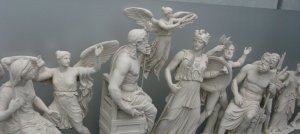
In the Homeric Hymn to Pallas (which was not translated into English by Chapman until a good many years after this play was printed) the subject is the same as that of the Parthenon pediment, namely, the circumstances attending the birth of the goddess. The earthquake and the commotion of the sea are first described, with the shaking of Olympus itself and the amazement of the gods and goddesses thereon ; then comes specially the reining in of his horses by Phoebus to watch the convulsion of nature ; but the Fates are not mentioned at all, although their amazement is one of the most significant things in the legend in marble. Whether Shakespeare had seen some model of the Parthenon, or some good print of it and of its principal sculptures, or some other marble showing the birth of Pallas, it does not appear possible to doubt that the great Athenian legend is the subject of the nonsense verses which are given to Bottom to declaim as a specimen of ” ‘Ercles’ vein.”
Past productions

The fairies sing Bianca Amato (Titania) to sleep during the dress rehearsal for "A Midsummer Night's Dream," performed by the Public Theater.
2010 – Public Theatre, Pittsburgh
Director: Ted Pappas
Pappas promises a “big production” with such a large set by James Noone, a regular Public set designer, that the theater had to rent an extra truck to haul in all the pieces.
“And, we are going to use the whole theater,” he said, “the balconies, the aisles, the trap door in the stage. We’ve never done a play with so many ways on and off [the stage]. And the actors will be speaking in the midst of the audience.”
The approach is another way of responding to Shakespeare’s concept that “all the world’s a stage,” Pappas said. “In this show, the audience is part of the play as well. It is in ‘The Dream’ right along with the actors.”
Read more: http://www.post-gazette.com/pg/10021/1029736-325.stm#ixzz1201mkeWC
2009 – Two River Theater Company, California Shakespeare
Director: Aaron Posner
Check out their website for blog posts, program notes, photos and video!
“Aaron Posner’s inspired creation at [Cal Shakes] is nothing short of brilliant. … Mr. Posner found that the beating heart of A Midsummer Night’s Dream is the mischief and humor and…gave it a new life.” —The San Francisco Appeal
2007 – Public Theatre, Central Park
Director: Daniel Sullivan

Keith David (Oberon), left, Laila Robins (Titania) and Jay O. Sanders (Bottom) in "A Midsummer Night's Dream" in Central Park.
Like some shape-shifting fairy “A Midsummer Night’s Dream” changes form and colors every time it is produced. Different aspects of the plot step forward to become, as it were, the lead singer, to let you know what the play is truly about. And in this instance it’s the rude mechanicals who remind us of the mysterious and exalting powers of make-believe, as well as the thrills and dangers of live theater.
… The look of this “Dream” is Victorian, as if the artist Arthur Rackham hadconfused assignments to illustrate Charles Dickens and the Brothers Grimm and wound up blending them together. The set designer Eugene Lee has whipped up a glorious blasted tree, garlanded in ivy, to serve as the center of fairy society. Ann Hould-Ward’s luscious costumes are big on bustles, bonnets and swallowtails. And the chorus of fairies who serve their queen, Titania (Laila Robins), are played, as in the days of Granville-Barker and Beerbohm Tree, by a phalanx of charming (and slightly menacing) children.
… In this “Dream” Oberon (Keith David) and Puck (Jon Michael Hill), the fairy king and his minion, are top-hatted music-hall wand wavers. They are stylish figures who nicely convey the detached amusement of otherworldly creatures watching mortals being fools.
–Ben Brantley, New York Times
2004 – Saratoga International Theatre Institute

Photograph by Dixie Sheridan. Anne Bogart (foreground) rehearses 'A Midsummer Night's Dream' with (from left) Chris Wells, Barney O'Hanlon and Karenjune Sanchez.
Director: Anne Bogart
Bogart chose America in the 1930s as the backdrop for this production. The Grapes of Wrath landscape emerged in the initial speech (transposed from Titania’s text in act 2) describing a catastrophe in nature that in this version has proceeded the action: “The ox hath therefore stretched his yoke in vain, / The plowman lost his sweat, and the green corn / Hath rotted ere his youth attained a beard . . .” Ellen Lauren’s effective delivery of the text brought to mind Steinbeck’s account of the enormous disruption in human life that accompanied the Dust Bowl in Oklahoma. Gabriel Berry’s imaginative costumes, Neil Patel’s silver expanse of Midwestern sky, and T.Griffin’s bluegrass-inspired music subtly recalled the Great Depression. By selecting this era as her landscape, Bogart emphasized the gap between rich and poor, and Berry’s costumes reflected these differences.
-Bonnie Jean Eckard (review requires access to Project Muse, provided by CMU)
 1996 – Northern Broadsides, the Globe
1996 – Northern Broadsides, the Globe
Director: Barrie Rutter
Barrie Rutter’s Northern Broadsides production of A Midsummer Night’s Dream arrived at the Globe just after finishing a tour of Brazil, spent two hours rehearsing on the stage in front of an audience of builders and pleasantly surprised tourists, and less than an hour later, the company were putting on their single performance to a packed Globe house.
… The first half was played in their own clothes – mostly jeans and T-shirts emblazoned with the company logo, a boar’s head. Rutter had warned the audience before the play began that three cases of costumes had been lost somewhere between Rio and Heathrow, so that as with their rapid acclimatising to the stage and space, the players had to improvise to make up for the loss of any help from costume in their characterisation – no mean feat when you are a 14-stone workman transformed into a fairy with nothing but movement and voice to disguise you.
Donkeys
From http://www.donkeyrescue.org:
The common ass is a direct descendant of the African Ass. These donkeys evolved in the arid deserts of Africa and are accustomed to dry, sparse vegetation. Donkeys are browsers by nature and are used to looking for edibles as they slowly wander along. This instinct to constantly look for food will result in problems if the donkeys are in an area with too much fresh grass.
Methinks I have a great desire for a bottle of hay.
Grass hay is the number one feed choice for donkeys. It is usually available in all areas of the country in one form or another. The benefit of grass hay, over other types of hay, is the low protein levels. To be beneficial to a donkey, the protein level must be below 5%. In a typical alfalfa hay, the protein levels can easily exceed 25%.
To say true, reason and love keep little company together nowadays.
There is no valid reason for any donkey owner to keep a whole jack or to breed donkeys in general. With so many donkeys losing their desert habitat and so many others waiting for adoptive homes, it is simply irresponsible to breed more.
A castrated donkey is healthy, happy and will live a life free from frustration. Of all the attacks on humans that Peaceful Valley has responded to, they have all been by uncastrated jacks. In every case, the owner said that their donkey had always been sweet and harmless and they did not know what came over them. An uncastrated jack is unpredictable and can seriously injure a person. In a recent rescue, Kenny was an uncastrated, 3 year old jack that was bottle fed and raised in the house. Once he hit sexual maturity, he viewed people as equals and considered anyone a potential rival or sexual partner. Kenny attacked a man and his grandchild and seriously injured the man as he tried to protect the child. Kenny will need years of training and work if he is ever to be safe around people.
Wild burros maintain their hooves by constantly moving along the rough desert terrain. Domestic donkeys are usually limited on their space and their hooves must be trimmed. Many factors can have an impact on hoof growth including: diet, weather, exercise and age.
Donkeys are very protective by nature and are often used as guard animals for sheep, goats and cows during calving. This does not mean that all donkeys are suitable for this function. Young donkeys are often too aggressive and may hurt or even kill small animals.
Donkeys are very adept at handling hot temperatures. Their long ears act as sails, catching the desert breeze and cooling the blood as it passes through them. In extreme conditions donkeys can survive without water for days without ill effect, second only to the camel.
Donkeys have no natural predators in the United States. In fact, they can fend off and even kill most predators found in this country.
Donkeys are viewed as a stubborn animal. In almost every language on the planet the term “jackass” is used as a slur. What is generally viewed as stubbornness is the donkey’s instinct to protect itself. If a donkey does not feel safe, or trust the person that is handling them, they simply will not cooperate. Any rational creature would react the same way.
Donkeys can run in excess of 30 MPH and jump over five feet high.
A donkey’s bray is sound generated on the inhale and exhale. Donkeys will usually only bray before feeding times, if they sense danger or if they are lonely. Donkeys are happier in pairs.
European Royalty
The Elizabethan administrative structure was highly centralized, with most actions centred on the Privy Council, which in turn was directly appointed by the monarch.
In the sixteenth century, the western world centered on Europe. America had only recently been discovered and was a land for adventurers and explorers to conquer and discover and bring back to Europe all kinds of wonders such as potatoes and tobacco. It was not a developed country architecturally or economically. The most important person in Europe was arguably the Pope who resided then, as now, in the Vatican at Rome. Roman Catholicism was still the dominant European religion and the Pope, as its head, wielded enormous power in Roman Catholic countries. Even in non-Roman Catholic countries such as England, the Pope had a great influence amongst those still adhering to the Roman Catholic faith.
The most powerful ruler, however, was Philip II of Spain. His father, Charles, had been one of the most powerful men ever to have lived in Europe. Not only was he King of Spain, but also governor of the Netherlands and Holy Roman Emperor, a very prestigious title indeed. Philip inherited the throne of Spain aswell as the Netherlands, was King of Portugal for a while, and owned lands in the Americas that were a source of great wealth. Unlike his father, Philip made Spain his central home and under his rule, Spain was at the height of its influence and recognized as the most powerful country in Europe, if not the world.
However, relations between Philip and his neighbors were poor. He was constantly in conflict with France, mismanaged the government of the Netherlands to the extent that there was open rebellion and eventual war there, and he came into conflict with Elizabeth. The powers of Europe were wary of Philip and Queen Elizabeth in particular tried to keep in check his wealth, and the potential threat Catholic Spain posed to Protestant England, by discretely authorizing her sailors to pirate his ships as they came from America. William Cecil, the Queen’s chief minister, did not approve of this, so Elizabeth tried to keep knowledge of what was going on from him. Not only did capturing a Spanish ship laden with treasure improve her finances, but it depleted Philip’s in the hope to stall his often threatened invasion of England, his so called “Enterprise of England.”
England and Spain were officially at war in 1585 after years of underhanded conflict, and the war lasted until the Queen’s death. Philip died in 1598, but his son, Philip III, continued the war, even though he did so half heartedly. He saw the conflict between Elizabeth and Philip as just that, a clash of personalities, and in many ways, perhaps that was the case.
… The Scandinavian countries were monarchies, Sweden and Denmark having their own sovereign. Norway was under the rule of the Danish. Sweden was a Protestant country and so in a tacit form of alliance with England, but it was not a particularly wealthy country. King Eric of Sweden hoped to marry Queen Elizabeth for some years, but his suit was unsuccessful.
Hungary and Poland were larger than they are today and were on the edge of the Turkish states belonging to the Ottoman Empire. The Ottomans were a considerable threat to Christian Europe (Christendom) and much effort was put into fighting them by Philip II who also governed Poland. For a century they had taken land after land and added it to their vast empire, but their strength was beginning to ebb as their internal government was slowly eaten by corruption. The Battle of Lepanto in 1571 was a turning point in European history, for after the defeat of the Ottomans by Philip, they never again posed such a threat to Christendom.
Russia was ruled by a Tsar and did not play a great part in the history of Elizabeth’s reign. However, Elizabeth was on good terms with Ivan IV, “The Terrible”. The Queen even once sent the Tsarina her own doctor.
The center of European trade was Antwerp (in the Netherlands). However, with the outbreak of the rebellion against Philip II, the center of trade slowly began to move to London. Many Protestant from the Netherlands fled to England during Elizabeth’s reign and brought with them craftsmanship skills that the English could learn.
Historical Context
A Midsummer Night’s Dream was first performed around 1594 or 1595.
- 1558-1603: Reign of Elizabeth I.
- 1588 forward: After the defeat of the Spanish Armada, repression of Catholicism increases.
- 1592-3: Plague periodically ravages London, closing the theaters. While the theaters are closed, Shakespeare writes his poems Venus and Adonis and The Rape of Lucrece.
- 1593: Alice, John and Agnes Samuel, the Witches of Warboys, are found guilty of witchcraft and hanged.
- 1593: Christopher Marlowe is killed in a bar-room brawl.
- 1594: The Lord Chamberlain’s Men take over the playing of Shakespeare’s plays, a company partially owned by Shakespeare.
- 1594: The Nine Years War, an uprising by Irish Catholics backed by Spain, begins. It lasts until 1603, a few days after Elizabeth I’s death.
- 1596: Blackfriar’s Theatre opens.
- 1596: Shakespeare’s son Hamnet dies at age 11.
Fairy Lands
Avalon
Some of our oldest legends depict fairies as visitors from a distant island, a realm beneath the sea, or a subterranean domain. Generically called faerie, this land is a place of splendor and luxury, a social utopia, and a refuge from hardship and illness. In the English-speaking world the most famous such paradise is Avalon (the Island of Apples), the home of King Arthur’s fairy sister Morgan Ie Fay. The Life of Merlin by Geoffrey of Monmouth contains the following description:
The Island of Apples, which is called the Fortunate Island, has its name because it produces all things for itself There is no work for the farmers in plowing the fields. All cultivation is absent except for what nature manages by herself. On its own the island produces fertile crops and grapes and native apples by means of its own trees in the cropped pastures.
On its own the overflowing soil puts forth all things in addition to the grass, and in that place one lives for one hundred years or more.
Tir na n’Og
Another legendary fairyland of great antiquity is Tir na n’Og (Land of Youth), usually perceived as an island west of Ireland, but also identified as an underground realm or a land beneath the sea. True to its name, the most prominent quality ofTir na nag is the suspension of the aging process for all who dwell there. The most famous human visitor to Tir na n’Og was the legendary Celtic poet and hero Ossian (also spelled Oisin), who went there with a fairy lover and spent 300 (or 150, according to some accounts) years there. Upon his return to earth his aging process accelerated, and he suddenly became a grizzled old man.
The suspension of time is a common motif in legends about visits to fairyland, wherever the location, and whatever the purpose of the visit. Washington Irving’s Rip Van Winkle was patterned after any number of European visitors to fairyland. Irving’s character fell asleep after accepting a drink from some dwarf-like characters in New York’s Catskill Mountains, then awoke after what he perceived to be an hour or two, only to discover that twenty years had lapsed.
Fairyland in Our Midst
If we have fairies literally beneath our feet, does that mean that we are competing with them for room? Numerous legends address this question, often attributing bad fortune to the violation of fairy space. Special precaution was called for in the construction of new buildings. An Irish legend tells how a man, planning to build a new house, first consulted a wise woman for advice on its placement. She made five heaps of stones at different places on his property, then told him to build on the location where the stones were not disturbed that night. The next morning, only one pile of stones remained standing, and so he built his house there.
Changelings
Abductions of individuals targeted to become fairies’ lovers and spouses are told throughout Europe, but even more common are accounts of stolen infants. The folkloric record makes it clear that pre-industrial Europeans’ greatest fear concerning fairies was that the latter would steal a newborn baby, leaving in its place a misshapen fairy child known as a changeling. Accounts of such abductions are found throughout Europe, and beyond, stretching from the pre-Christian era into the twentieth century.
As late as 1924 it was reported that in sections of rural Germany many people were still taking traditional precautions against the supernatural exchange of infants. Outside of Europe the opinion survived even longer. Writing in 1980, Hasan M. El-Shamy reports: “The belief that the jinn may steal a human infant and put their own infant in its place is widespread in numerous parts of Egypt”.
This superstition’s longevity and widespread distribution is easily explained.
We all want reasons for events that fall outside of our control, especially those that have a direct bearing on our welfare. The changeling belief explained why some children fail to develop normally and justified the withdrawal of family support for such handicapped individuals.
Descriptions of fairy changelings gleaned from a sampling of legends suggest that the stories ultimately stemmed from actual experiences with children suffering from such ailments as autism, Down syndrome, hydrocephalus, or any other condition that resulted in a child’s failure to thrive and develop properly. Symptoms specifically described in the legends include a swollen head, strangely staring eyes, a flat nose, incessant crying, misbehavior, failure to learn to talk or walk, and a voracious appetite.
A noteworthy aspect of most changeling legends is that the parents whose child was misbehaving or failing to properly develop were not the ones who first suggested that the infant was a changeling. This diagnosis typically was made by someone outside the family: a priest, neighbor, landlord, fairy doctor, or even a perfect stranger. There was thus a shared responsibility for any actions that followed, and these were often very drastic. A standard approach was to torture the suspected changeling, thus forcing its fairy parents to rescue it. The abuses inflicted on these babies were unspeakably cruel, and if actually carried out would have been fatal.
… It is impossible to determine how often these extreme punishments were actually inflicted on malformed or mentally retarded children. In 1826 in Jalee, Ireland, a grandmother drowned her four-year-old grandson, who could neither stand, walk, nor speak. Brought to trial, she testified that she had not intended to kill the child, but rather “to put the fairy out of it.” She was found not guilty.
Cruel abuse was not the only way to force demonic parents to reclaim their misshapen children, although this was the most frequently described method. A more humane approach was to force the changeling to laugh or to make him utter an expression of surprise, which-according to popular belief-would expose his true identity and force his supernatural parents to take him away.
Brewery of Eggshells
IN Treneglwys there is a certain shepherd’s cot known by the name of Twt y Cymrws because of the strange strife that occurred there. There once lived there a man and his wife, and they had twins whom the woman nursed tenderly. One day she was called away to the house of a neighbour at some distance. She did not much like going and leaving her little ones all alone in a solitary house, especially as she had heard tell of the good folk haunting the neighbourhood.
Well, she went and came back as soon as she could, but on her way back she was frightened to see some old elves of the blue petticoat crossing her path though it was midday. She rushed home, but found her two little ones in the cradle and everything seemed as it was before.
But after a time the good people began to suspect that something was wrong, for the twins didn’t grow at all.
The man said: “They’re not ours.”
The woman said: “Whose else should they be?”
And so arose the great strife so that the neighbours named the cottage after it. It made the woman very sad, so one evening she made up her mind to go and see the Wise Man of Llanidloes, for he knew everything and would advise her what to do.
So she went to Llanidloes and told the case to the Wise Man. Now there was soon to be a harvest of rye and oats, so the Wise Man said to her, “When you are getting dinner for the reapers, clear out the shell of a hen’s egg and boil some potage in it, and then take it to the door as if you meant it as a dinner for the reapers. Then listen if the twins say anything. If you hear them speaking of things beyond the understanding of children, go back and take them up and throw them into the waters of Lake Elvyn. But if you don’t hear anything remarkable, do them no injury.”
So when the day of the reap came the woman did all that the Wise Man ordered, and put the eggshell on the fire and took it off and carried it to the door, and there she stood and listened. Then she heard one of the children say to the other:
Acorn before oak I knew,
An egg before a hen,
But I never heard of an eggshell brew
A dinner for harvest men.
So she went back into the house, seized the children and threw them into the Llyn, and the goblins in their blue trousers came and saved their dwarfs and the mother had her own children back and so the great strife ended.
The bushes parted. In the very spot where Dan had stood as Puck they saw a small, brown, broad-shouldered, pointy-eared person with a snub nose, slanting blue eyes, and a grin that ran right across his freckled face. He shaded his forehead as though he were watching Quince, Snout, Bottom, and the others rehearsing Pyramus and Thisbe, and, in a voice as deep as Three Cows asking to be milked, he began:
'What hempen homespuns have we swaggering here,
So near the cradle of the fairy Queen?'
He stopped, hollowed one hand round his ear, and, with a wicked twinkle in his eye, went on:
'What, a play toward? I'll be an auditor;
An actor, too, perhaps, if I see cause.'
The children looked and gasped. The small thing – he was no taller than Dan’s shoulder – stepped quietly into the Ring.’I’m rather out of practice,’ said he; ‘but that’s the way my part ought to be played.’
Still the children stared at him – from his dark-blue cap, like a big columbine flower, to his bare, hairy feet. At last he laughed.
‘Please don’t look like that. It isn’t my fault. What else could you expect?’ he said.
‘We didn’t expect any one,’ Dan answered slowly. ‘This is our field.’
‘Is it?’ said their visitor, sitting down. ‘Then what on Human Earth made you act Midsummer Night’s Dream three times over, on Midsummer Eve, in the middle of a Ring, and under – right under one of my oldest hills in Old England? Pook’s Hill – Puck’s Hill – Puck’s Hill – Pook’s Hill! It’s as plain as the nose on my face.’
He pointed to the bare, fern-covered slope of Pook’s Hill that runs up from the far side of the mill-stream to a dark wood. Beyond that wood the ground rises and rises for five hundred feet, till at last you climb out on the bare top of Beacon Hill, to look over the Pevensey Levels and the Channel and half the naked South Downs.
‘By Oak, Ash, and Thorn!’ he cried, still laughing. ‘If this had happened a few hundred years ago you’d have had all the People of the Hills out like bees in June!’
‘We didn’t know it was wrong,’ said Dan.
‘Wrong!’ The little fellow shook with laughter. ‘Indeed, it isn’t wrong. You’ve done something that Kings and Knights and Scholars in old days would have given their crowns and spurs and books to find out. If Merlin himself had helped you, you couldn’t have managed better! You’ve broken the Hills – you’ve broken the Hills! It hasn’t happened in a thousand years.’
‘We – we didn’t mean to,’ said Una.
‘Of course you didn’t! That’s just why you did it. Unluckily the Hills are empty now, and all the People of the Hills are gone. I’m the only one left. I’m Puck, the oldest Old Thing in England, very much at your service if – if you care to have anything to do with me. If you don’t, of course you’ve only to say so, and I’ll go.’
He looked at the children, and the children looked at him for quite half a minute. His eyes did not twinkle any more. They were very kind, and there was the beginning of a good smile on his lips.
Una put out her hand. ‘Don’t go,’ she said. ‘We like you.’ ‘Have a Bath Oliver,’ said Dan, and he passed over the squashy envelope with the eggs.
‘By Oak, Ash and Thorn,’ cried Puck, taking off his blue cap, ‘I like you too. Sprinkle a plenty salt on the biscuit, Dan, and I’ll eat it with you. That’ll show you the sort of person I am. Some of us’ – he went on, with his mouth full – ‘couldn’t abide Salt, or Horse-shoes over a door, or Mountain-ash berries, or Running Water, or Cold Iron, or the sound of Church Bells. But I’m Puck!’
He brushed the crumbs carefully from his doublet and shook hands.
‘We always said, Dan and I,’ Una stammered, ‘that if it ever happened we’d know ex-actly what to do; but – but now it seems all different somehow.’
‘She means meeting a fairy,’said Dan. ‘I never believed in ’em – not after I was six, anyhow.’
‘I did,’ said Una. ‘At least, I sort of half believed till we learned “Farewell, Rewards”. Do you know “Farewell, Rewards and Fairies”?’
‘Do you mean this?’ said Puck. He threw his big head back and began at the second line:
'Good housewives now may say,
For now foul sluts in dairies
Do fare as well as they;
And though they sweep their hearths no less
(‘Join in, Una!’)
Than maids were wont to do,
Yet who of late for cleanliness
Finds sixpence in her shoe?'
The echoes flapped all along the flat meadow. ‘Of course I know it,’ he said.’And then there’s the verse about the rings,’ said Dan. ‘When I was little it always made me feel unhappy in my inside.’
“‘Witness those rings and roundelays”, do you mean?’ boomed Puck, with a voice like a great church organ.
'Of theirs which yet remain,
Were footed in Queen Mary's days
On many a grassy plain,
But since of late Elizabeth,
And, later, James came in,
Are never seen on any heath
As when the time hath been.
‘It’s some time since I heard that sung, but there’s no good beating about the bush: it’s true. The People of the Hills have all left. I saw them come into Old England and I saw them go. Giants, trolls, kelpies, brownies, goblins, imps; wood, tree, mound, and water spirits; heath-people, hill-watchers, treasure-guards, good people, little people, pishogues, leprechauns, night-riders, pixies, nixies, gnomes, and the rest – gone, all gone! I came into England with Oak, Ash and Thorn, and when Oak, Ash and Thorn are gone I shall go too.’Dan looked round the meadow – at Una’s Oak by the lower gate; at the line of ash trees that overhang Otter Pool where the millstream spills over when the Mill does not need it, and at the gnarled old white-thorn where Three Cows scratched their necks.
‘It’s all right,’ he said; and added, ‘I’m planting a lot of acorns this autumn too.’
‘Then aren’t you most awfully old?’ said Una.
‘Not old – fairly long-lived, as folk say hereabouts. Let me see – my friends used to set my dish of cream for me o’ nights when Stonehenge was new. Yes, before the Flint Men made the Dewpond under Chanctonbury Ring.’ Una clasped her hands, cried ‘Oh!’ and nodded her head.
‘She’s thought a plan,’ Dan explained. ‘She always does like that when she thinks a plan.’








